■This is the 萩生寺 (HAGYUJI TEMPLE)
Butsugen Buddha's Eyes
There is an old Japanese proverb: "The eye speaks as much as the mouth and is the window of the heart."
The eye provides the deepest expression of the face. To look into the eyes and thereby understand the heart is truth itself. The study of physiognomy explains the expressions of the eye. Ladies who make their eyes up fashionably find it to be the most difficult part of applying cosmetics. When artists draw animals, they usually paint in the eyes last because of this. Thus, the eyes are very important both for seeing and for others to see them. We cannot really separate the eyes from the heart. Therefore, we call the "Eye of the heart" Shingan.
On a Buddhist altar, there is a mokugyo (wooden drum). When a monk hits the mokugyo while chanting a sutra, it opens up our eyes and heart, just like the eyes of fish, which are always open. The open eye symbolizes observing yourself. Because of this, the mokugyo is designed in the form of a fish eye.

In Mikkyo, the secret teaching, the meaning of Butsugenson is said to be the meaning of all Buddhas, or "The Goddess of Buddha's Eyes." The symbol of this goddess is the virtue of five eyes. These eyes represent the wisdom of Buddha. The five eyes are: the naked eye, the celestial eye, the eye of wisdom, the eye of Daruma, and the Buddha eye. This information is contained in a scripture of the Daichido-ron, a sutra work that also gives information on various philosophical views in India. In this work, there is a mantra that says, "the naked eye sees only that which is close and not far, only the front and not the back, only up but not down. Yet, the celestial eye sees the front and back, the up and down, the distance, but not the truth of the objects. The eye of wisdom sees through the truth, and has that wisdom, but the wisdom remains within. The eye of the Daruma sees what is best for self and others in any circumstance. And the Buddha's eye sees through all things in the universe."
This sounds very difficult but do not be caught in these details because the Daichido-ron explains the step by step process to follow in attaining the knowledge of the truth of all things. This is done with Ganriki, which his the power of the eye.
Neither the naked eye, the celestial eye, nor the Buddha eye are enough to see through the truth of things. But with the use of all five eyes, the truth can be seen.
The painted set of eyes of Hagyu temple is influenced by temples in Bordonart Nepal, and various temples in Tibet. The Buddha eye expresses Ganriki, the power of the eye, crefully observing the minutiae of everything in the universe, whereas the nose symbolizes the searching mind of human beings and looking for the truth.
We human beings are born and live on this earth, a small planet in the universe where we deal with all sorts of problems such as energy, environment, pollution, shortage of food, and racial tensions. These are problems that our human society has to deal with. But we are also able to express joy, anger, and other emotional feelings.
Our human society is always moving forward into the future, in this space in the universe which we occupy. If we are to go forward, we need to use the power of the eye with discemment towards all human beings. We need to look not with the naked eye, but with the Buddha eye. We need to keep develping ourselves to attain the Buddha eye.
That is the temple's hope for us, symbolized by the painting of Buddha eyes on the facade of the Main Hall.
Ryoumen Daishi
Kobo Daishi was the founder of Esoteric Buddhism (Shingon Shu). He entered into eternal Samadhi at 2:00 am on March 21,835 AD in Chuin Temple (present Ryukouin) on Mount Koya.
His disciples asked Kobo Daishi what sort of appearance he embody when he hied out. He told them that in his left hand he would hold a nengju (rosary) and in his right, a gokosho (bell) in the figure of a prayer. Shin Nyo Shinnyo painted this figure on the back of a screen, which is displayed at the Mie Do on Mount Koya. After Kobo Daishi passed away at Chuin, his figure was well-known to the public as a omie (shadow).
Another well-known representation of Daishi, Takahatsu Sugata (Begging Figure), shows him holding a shakujo (walking staff decorated with a metal ring on top) in his right hand and a teppatsu (begging bowl) in his left hand.
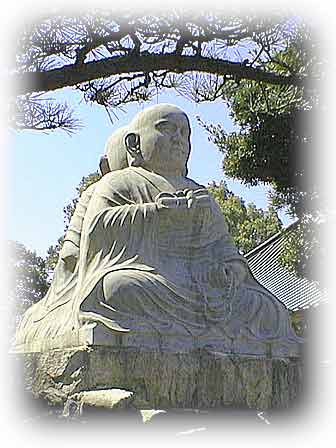
Daishi has also been represented in a form called The Secret Daishi. His figure holds Riken (the sword of Bodhisatva Manjusri) and interprets the Hannya Shingyo (Prajna paramita sutra).
He explains this in his writing, Hannya Shingyo Hiken (The Secret Key to the Heart Sutra). In this sutra, there is a very important element that shows the way towards attaining enlightenment.
The sharp sword of Manjusri cuts off wild speculations;
The sacred words of Prajna guide us to perfect self-control.
Dhih and Mam are the seed mantras of these Bodhisattvas;
They are the dharanis which comprise manifold teachings.
From the endless cycle of samsara how can we be freed?
The only way is to practice meditation and correct thinking.
The samadhi of Prajna is expounded by the Buddha himself;
May His mercy be poured on me who am about to interpret it.
Only one temple in Japan, Hagyu-ji, possesses a very rate representation of Kobo Daishi. It is called Ryoumen Daishi and was created in 1993.
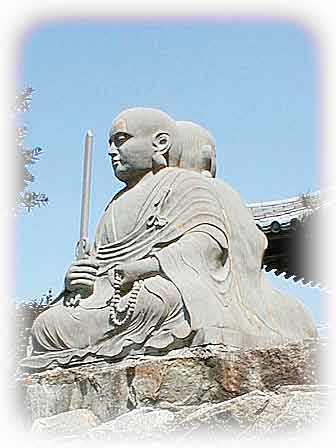
Chika Osunafimi Reijo
In the basement chamber of our temple, there is sacred sand from Lumbini, Bodhgaya, Sarnath, and Kusinagara in India, and also sand from Seiryu-ji of Chang-An in China. There is also sand from Saniyu-san Kannon Reijyo in Western Japan and sand from Hachi-ju Hachi Reijyo (Pilgrimage Circuit of 88 Temples) in Shikoku. The basement also houses a wooden sculpture of the Buddhas.
Lumbini is the sacred plase where Shakyamuni Buddha was born. Bodhgaya was the plase where Shakyamuni attained enlightenment after long meditation. Sarnath is the place where he preached his first sermon, and Kusinagura is the sacred place where he enters Nirvana.
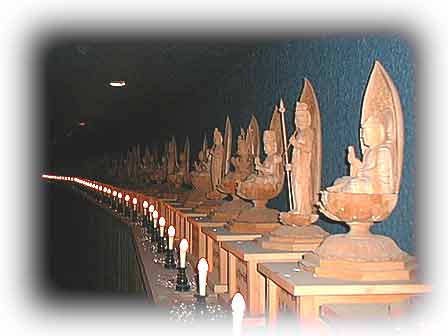
Seiryu-ji (Ching-Long Temple), Chang-An in China is the place where Kobo Daishi (Kukai) was given the secret teaching of Mikkyo from Keika Ajyari (Hui-Guo A-Jia-Li 746-805). Saikoku Sanjyu-san Kannon Reijyo was established and opened by Tokudo Shounin of Yamato Hasedera during the Nara Period in 718 AD. One hundred years later, Shikoku's Hachi-ju Hakkasho Reijyo was established.
The sacred sand in the subterranean chamber of Hagyu-ji Temple was collected by the chief priest of the temple during his travels to these sacred places in Japan and other parts of Asia. It is our wish that people will come to this chamber and experience the stepping on these sands if they cannot visit India, China, or Japan. People gain the same merit when they come to this chamber.
The chamber is 110 meters long which circumambulates below the Main Hall. If you have a chance, please come and visit us.
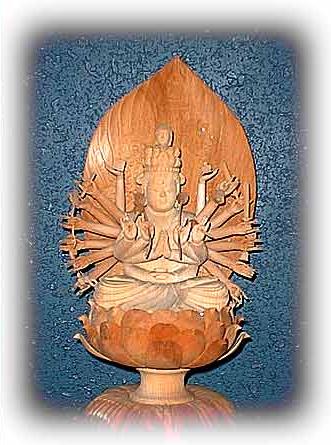
MEDITATION & MULTIPURPOSE HALL was opened !!
On November 4th 2001, the "UNDERGROUND" MEDITATION & MULTIPURPOSE HALL was opened featuring an Odissi Dance in dedication to the first appearance of BUDDHA since 1951.
The BUDDHA appears from our temple ZUSI (厨子), 0nce each 50 years. Our hall opening was held in respect of this year appearance.
Miss KIMIKO YANAGIDA dedicated her beautiful and wonderful odissi dance to commemorate the opening.
We have completed the HAGYUJI-SINTOKAIKAN for purpose of meditation and various performances. Our great hall will be utilized for any artistic activities, dances, music, songs and various exhibitions. The use of this hall will be created by your wisdom and your needs. We hope that you and our community can develop our great hall for use by all.
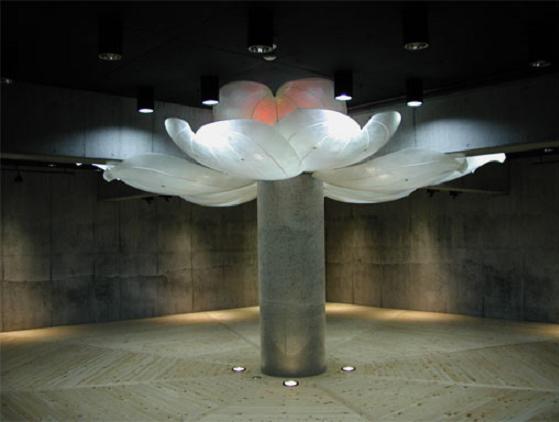
UNDERGROUND MULTIPURPOSE HALL
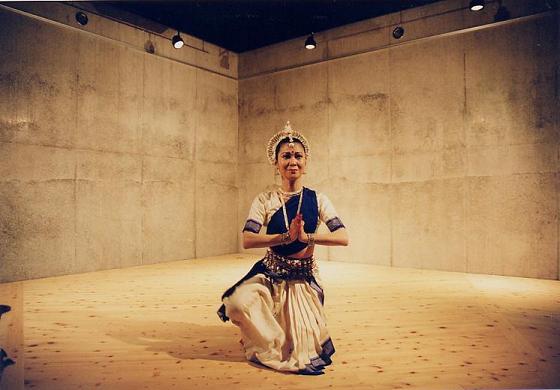
Miss KIMIKO YANAGIDA was dancing in dedication to commemorate the opening of multipurpose hall